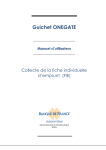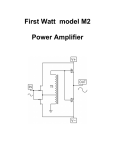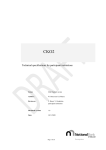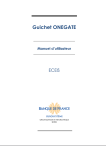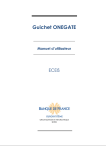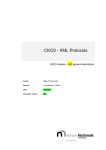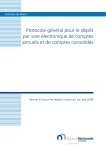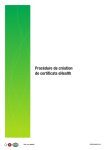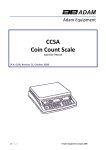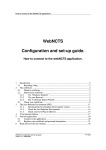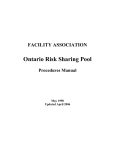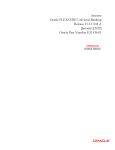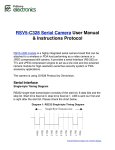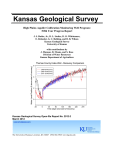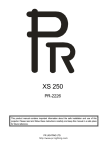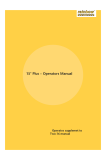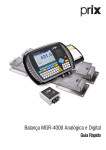Download OneGate(CSSR)
Transcript
For assistance on filling the meta data fields of this document, just activate the Show/Hide (¶)
function
OneGate(CSSR)
Web Services
End User Manual
PSD:
CRS
Project code:
CRS
Department Group:
PRSM
Author:
PRSM
Date:
10/09/2010
Version :
2.0
Status:
Draft
Authorized by:
Ronny Martin
Reviewers:
PRSM, DQ
Commentators:
PRSM, DQDQ, External partners
Approvers:
Cellule Research and Development (DQ)
Location:
http://teamn.prd.nbb/sites/CRS/Shared
Documents/DQ07CSSRINT/User's manuals - External/OneGate(CSSR) - End User Manual Web Services.docx
Abstract: This document template is to be used for writing the End User Manual for a developed business service or product. It
forms part of the System Development Life Cycle (SDLC). There are separate user manuals for operatos/administrators and for
developers of the service.
© National Bank of Belgium, Brussels
All rights reserved.
Reproduction for educational and noncommercial purposes is permitted provided
that the source is acknowledged.
OneGate(CSSR)
End User Manual
Table of Contents
1. Introduction
1.1
1.2
1.3
4
Document history
References
Overview of document
4
4
5
2. Product features and capabilities
6
2.1
2.2
2.3
Product purpose
Scope of intended use
Scenario
6
7
7
3. Generalities
3.1
3.2
3.3
3.4
3.5
3.6
3.7
9
Interoperability
Authentication
Authorization
Secure data
Binary data
Volume
Useful tools
9
10
10
10
11
11
11
4. Web Services description
12
4.1
4.2
4.3
4.4
4.5
4.6
Overview
Upload file
Request list of available feedback
Request a feedback
Request list of available messages
Request a message
5. Error codes
5.1
5.2
12
12
15
17
19
22
25
HTTP Error code
SOAP Fault
25
25
6. Definition of terms and abbreviations
3
26
OneGate(CSSR)
End User Manual
1. Introduction
This document contains everything you need to automate the data exchange with the application OneGate(CSSR).
This document describes the prerequisites of the usage of the OneGate(CSSR) Web Services, the goal of each
one of them, its input, output and possible errors.
Target audience for this document is the external partners who wish to automate the data exchange with the
application OneGate(CSSR) using the Web Services.
1.1
Document history
Date
Version
Author
Description of change
19/11/2009
- Draft
PRSM
Initial version
11/02/2010
- Draft
PRSM
Update namespace
05/08/2010
- Draft
PRSM
Correction of some element definition
10/09/2010
2.0
PRSM
New Web Services description
1.2
Ref.
[1]
References
Title
Author
OneGate(CSSR) - End user manual
DQ
1
Location
French
Dutch
2
[2]
OneGate(CSSR) - End User manual - HTTPS Entrypoints
PRSM
English
[3]
OneGate(CSSR) - XML Protocol
PRSM
[Not available]
[4]
File Exchange Mechanism - S/MIMEv2 Specifications
SYAS
3
[Not available]
[5]
NBB Certificate policy
DSM
4
French
Dutch
[6]
NBB Certificate Practice Statement for External Counterparties
(CPS)
DSM
French
Dutch
[7]
Certificate management
DSM
English
[8]
Enrollment procedure v3.2
DSM
[Not available]
1
DQ:Department General Statistics
2
PRSM: IT Applications
3
SYAS: Network & Application Security
4
DSM: Data Security Management
4
OneGate(CSSR)
1.3
End User Manual
Overview of document
This manual is structured as follows:
Section
Title
Main Purpose
1
Introduction
Specifies the document version, lists
other,
related
documents
and
summarises the contents of this
manual
2
Product description and environment
Explains why the product exists, its
scope and the scenario analysed
3
Generalities
Describes the generic points about
the usage of the Web services.
4
Web services description
Explains how to use the product
5
Error codes
Lists and explains product error codes
and associated corrective actions
6
Defininiton of terms and abbreviations
Lists and explains any special terms
used in the document.
5
OneGate(CSSR)
End User Manual
2. Product features and capabilities
2.1
Product purpose
Today, the need for information grows continuously. Administrative and statistical institutes interview
the citizens and companies regularly to collect this information. With the dematerialization, the paper
form has given way to electronic form sent via the Internet. The goal of the application One Gate
(CSSR) is to become a unique point of data collection and data exchange for the National Bank of
Belgium.
The data collection can be done either manually by filling an online form either (semi) automatically by
sending a XML file via a manual file upload, a secured email or a web service call. The current
document is limited to the description of the fully automated data exchange using the Web Services
(drawn in Figure 1 under point 3). You can also fully automated the data exchange using the HTTPS
entrypoints instead of the Web Services. The HTTPS entrypoints are described in document [2].
Figure 1 - General overview
6
OneGate(CSSR)
2.2
End User Manual
Scope of intended use
OneGate(CSSR) can be used for all business domain where data must be collected via Internet. Only the
authorized users can use the OneGate(CSSR) web services.
Once you have done the technical effort to automate the exchange for a certain business domain, you can reuse
this implementation for all the other business domain.
2.3
Scenario
For the data collection process, the data exchange with the application OneGate(CSSR) consists of four
chronological activities:
The declarer sends a file containing one declaration report.
The declarer requests the list of the available feedbacks.
The declarer requests a specific feedback.
The declarer submits an HTTPS request with the URL of the different attachments in the specific feedback
and the server responds with the content of the attachment.
Declarer A2A
ESB
OneGate (CSSR)
UploadFileRequest
UploadFileResponse
ProcessFile
FeedbackListRequest
FeedbackListRequest
FeedbackListResponse
SOAP request
(web services)
FeedbackListResponse
{For each entry of the
FeedbackListResponse}
FeedbackRequest
FeedbackRequest
FeedbackResponse
HTTPS request
(HTTPS entrypoints)
FeedbackResponse
(contains only URL(s) where
feedbacks can be retrieved)
Feedback File Server
{For each attachment in
the FeedbackResponse}
HTTPS GET <attachment URL>
(using URL(s) received
in FeedbackResponse)
Feedback
Figure 2 - Scenario of the fully automated data exchange with OneGate(CSSR) for data collection
7
OneGate(CSSR)
End User Manual
For the message consultation process, the data exchange with the application OneGate(CSSR) consists of three
chronological activities:
The declarer requests the list of the available messages.
The declarer requests a specific message.
The declarer submits an HTTPS request with the URL of the different attachments in the specific message
and the server responds with the content of the attachment.
Figure 3 - Scenario of the fully automated data exchange with OneGate(CSSR) for message consultation
The content of the FeedbackResponse/MessageResponse is one (or several) URL(s) where the
feedback/message can be retrieved. The feedback/message can be retrieved by using an HTTPS GET request to
this URL. This implies that the declarer must work with two different sessions, a SOAP and an HTTPS session, and
must authenticate in both sessions.
More detailed information concerning HTTPS request and HTTPS entrypoints can be found in document [2].
8
OneGate(CSSR)
End User Manual
3. Generalities
This chapter describes the generalities about the OneGate(CSSR) Web Services: the communication protocol, the
authentication, the authorization and the binary data format.
3.1
Interoperability
The W3C defines a Web service as a software system designed to support interoperable machine-to-machine
interaction over a network. It has an interface described in a machine-processable format (specifically WSDL).
Other systems interact with the Web service in a manner prescribed by its description using SOAP messages,
5
typically conveyed using HTTP with an XML serialization in conjunction with other Web-related standards.
WSDL
The WSDL describing to the Web services is available at the following URL:
URL- WDSL
This WSDL contains the description of the services, their input and output messages as well as the URL where the
they are made available.
SOAP
The external systems will interact with the OneGate(CSSR) Web services using SOAP messages over HTTPS (cfr.
3.2 & 3.3). The SOAP message will not contain specific SOAP Header neither in the request nor in the response.
In the SOAP web services world, when a fault occurs due to a client or a server mistake, a SOAP fault is
generated. A SOAP fault consists of a fault code, a fault string and optional a detail. The following draws the
generic format of the SOAP fault returned in case of a client error and a server error.
Note that in case of authenticate or authorisation error, you will not receive a SOAP fault but an HTTP error code.
Generic format of a client fault
<SOAP-ENV:Envelope
xmlns:SOAP-ENV="http://schemas.xmlsoap.org/soap/envelope/"
xmlns:xsi="http://www.w3.org/2001/XMLSchema-instance"
xmlns:xsd="http://www.w3.org/2001/XMLSchema">
<SOAP-ENV:Header/>
<SOAP-ENV:Body>
<SOAP-ENV:Fault>
<faultcode>SOAP-ENV:Client</faultcode>
<faultstring>Validation error</faultstring>
<faultactor></faultactor>
<detail>
<spring-ws:ValidationError
xmlns:spring-ws="http://springframework.org/spring-ws">
cvc-complex-type.2.4.b: The content of element 'tns:FeedbackRequest'
is not complete. One of '{"http://www.onegate.eu/2010-0101":FeedbackId}' is expected.
</spring-ws:ValidationError>
</detail>
5
http://www.w3.org/TR/ws-arch/
9
OneGate(CSSR)
End User Manual
</SOAP-ENV:Fault>
</SOAP-ENV:Body>
</SOAP-ENV:Envelope>
Generic format of a server fault
<SOAP-ENV:Envelope
xmlns:SOAP-ENV="http://schemas.xmlsoap.org/soap/envelope/"
xmlns:xsi="http://www.w3.org/2001/XMLSchema-instance"
xmlns:xsd="http://www.w3.org/2001/XMLSchema">
<SOAP-ENV:Header/>
<SOAP-ENV:Body>
<SOAP-ENV:Fault>
<faultcode>SOAP-ENV:Server</faultcode>
<faultstring>
An internal error occured. Please try again. If problem persist,
please send the fault detail to the system administrator.
</faultstring>
<faultactor></faultactor>
<detail>No details</detail>
</SOAP-ENV:Fault>
</SOAP-ENV:Body>
</SOAP-ENV:Envelope>
3.2
Authentication
The communication protocol used is HTTPS with SSLv3 certificate based authentication. The certificate based
authentication means that remote users get authenticated using a X509 certificate.
The application OneGate(CSSR) recognizes the certificate from NBB, Global Sign, Certipost and Isabel. If you
never used your certificate to access one of the NBB applications, you need to register your certificate. If you try to
consume one of the web services without having registered your certificate before, you will receive an HTTP 401
error code.
You can find more information about the certificate policy and registration in the "OneGate(CSSR) - End user
manual" (Ref.[1]) ; and about the NBB certificates in the referred documents [5] to [8].
3.3
Authorization
When your certificate is registered at the NBB, you must request access with this certificate to the application
OneGate(CSSR). The authorization process is based on security role. To request the role that will give you access
to the application OneGate(CSSR), you need to follow the procedure described in document [1]. Once the authority
approved your access request, you will be able to use your certificate to automate the data exchange and have
access to the online application.
If you try to consume one of the Web services without having requested access before, you will receive an HTTP
403 error code.
3.4
Secure data
OneGate(CSSR) supports the exchange of secure data. By secure, we means signed data or signed and
encrypted data. Depending of the data sensitivity, the business will be required to send the data:
without additional signing or encryption
signed: to authenticate the sender and guarantee the data integrity
signed and encrypted:
o authenticate the sender and guarantee the data integrity
o guarantee that only the receiver can read the data
10
OneGate(CSSR)
End User Manual
Exchange of signed and/or encrypted files from/to the NBB will occur with files which comply with the S/MIMEv2
standard described in document referenced by [4]. Once the file is signed and/or encrypted, it must be encoded in
base 64 to be sent via SOAP.
Certificate
User certificate: read 3.2 Authentication to know which certificate can be used to sign data.
Server certificate: the public key of the server certificate to used to encrypt/sign data is available on the
OneGate(CSSR) web site.
3.5
Binary data
The data exchange between the declarer and the application OneGate(CSSR) will be done using different file
formats (XML, PDF, Word document, ...) and different levels of security. This regarding, the file will be encoded in
base 64 in the SOAP request.
3.6
Volume
The size of the request can not exceed 10 MB. To limit the size of the request, the file can be compressed. If zip is
used, the contentType of the attachment will be “application/zip”.
3.7
Useful tools
Before automated the implementation of the Web services, you can easily test it using:
soapUI (http://www.soapui.org)
soapUI is a free and open source desktop application for inspecting, invoking, developing Web Services.
curl (http://curl.haxx.se)
curl is a command line tool for transferring files with URL syntax, supporting FTP, FTPS, HTTP, HTTPS,
SCP, SFTP, TFTP, TELNET, DICT, LDAP, LDAPS and FILE. curl supports SSL certificates, HTTP POST,
HTTP PUT, FTP uploading, HTTP form based upload, proxies, cookies, user+password authentication
(Basic, Digest, NTLM, Negotiate, kerberos...), file transfer resume, proxy tunneling and a busload of other
useful tricks.
11
OneGate(CSSR)
End User Manual
4. Web Services description
4.1
Overview
Figure 4 - Web services defined in the WSDL
Figure 4 gives an overview of the web services used by the declarer to fully automate the data exchange with the
application OneGate(CSSR). As a reminder, the data exchange consists of sending data and retrieving the
associated feedback which contains the result of the validation of the imported data or retrieving the available
messages.
4.2
Upload file
4.2.1
Description
The declarer uses the service "Upload file" to send a file with a declaration report to be processed by the
application OneGate(CSSR) and receives a ticket in return. This ticket is used as an acknowledgement of the file
receipt and will be used to uniquely identify the file transfer. The processing of the file is done asynchronously
following the FIFO principle. Due to the asynchronous process, the validation report will not be available immediatly
and there is a delay between the file upload and the registration of the file reception in OneGate(CSSR).
Note that the processing of the declaration can be also followed via the online OneGate(CSSR) application using
the function "Exchanges > File exchange log".
The sent file contains a declaration report that must follow the data exchange protocol published by the business
where the XML schema and the security level will be specified.
List of the XML protocol supported:
Declaration Report (cfr. [3]) ; all new reporting
XML protocol of the old CSSR application
12
OneGate(CSSR)
End User Manual
Supported security level to apply to the sending file:
None
Signed
Signed and encrypted
4.2.2
Input
UploadFileRequest
Description
Contains the file with the declaration report to upload to the application
OneGate(CSSR)
XML format
ComplexType
Children
FileName
UploadFile
FileName
Description
File name of the upload file
XML format
xs:String
whitespace = collapse
Validation
Optional
UploadFile
Description
File which contains the declaration report
XML format
xs:base64Binary
Validation
Required
More details about the element "UploadFile"
Before being encoded in base 64, the file must fulfil the following requirements:
The declaration report must be valid against the XML protocol fixed by the business
Only one file can be uploaded by sending.
The file can be compressed. In this case, the zip file can contains only one file.
Following the business requirements, the file must be signed or signed and encrypted.
So to build the value of the element UploadFile, you need to execute the following steps:
Validate the file against the XML schema ; optional but recommended
Zip file ; optional but recommended
Sign the file with your private key ; required or not by the business requirement
Encrypt the file with the OneGate(CSSR) public key ; required or not by the business requirement
Encode the file in base 64 ; required
13
OneGate(CSSR)
4.2.3
End User Manual
Output
UploadFileResponse
Description
Contains the ticket id associated with the file exchange.
XML format
ComplexType
Children
TicketID
TicketID
Description
Identify the file transfer uniquely.
The ticket ID is used as an acknowledgement of the file receipt and will be requested
in case of problem by the Service Desk to be able to detect the problem.
XML format
xs:string
whiteSpace=collapse
Validation
4.2.4
Required
Error message
Error message
Corrective action
Validation error
The SOAP request is not valid against the message
definition. Please consult the validation error details.
14
OneGate(CSSR)
End User Manual
4.3
Request list of available feedback
4.3.1
Description
The service "feedbackListRequest" is used to request the list of feedback identifiers available. Only the identifier of
the feedback associated with a file sent with this user will be sent back. The feedback associated with files sent by
another user but for a common declarer will not be sent back.
You can choose between requesting a list of either new feedbacks or feedbacks associated to files sent during a
specified time frame. The second option offers you the possibility to request feedbacks that have been retrieved
earlier.
4.3.2
Input
FeedbackListRequest
Description
Contains the attributes to request the list of feedback identifier available for the
requester.
XML format
ComplexType
Children
NotRead
Read
NotRead
Description
Used to request the identifiers of new feedback.
XML format
ComplexType
Validation
Empty element
Read
Description
Used to request the identifiers of feedback requested earlier and associated to files
sent during the specified time frame.
XML format
ComplexType
Children
TimeFrame
TimeFrame
Description
Specified the time frame during which the file has been received by the application
OneGate(CSSR).
XML format
ComplexType
Children
FromTime
ToTime
15
OneGate(CSSR)
End User Manual
FromTime
Description
Timestamp identifying the start of the time frame.
XML format
xs:dateTime
Validation
Required
ToTime
Description
Timestamp identifying the end of the time frame.
XML format
xs:dateTime
Validation
Required
4.3.3
Output
FeedbackListResponse
Description
Contains the list of the available feedback identifiers.
XML format
ComplexType
Children
NoFeedback
Feedback
NoFeedback
Description
No feedback found for the specified search criteria.
Not read: no new feedback
Read: no feedback read during the specified time frame
XML format
ComplexType
Validation
Empty element
Feedback
Description
Contains the information about the feedback available for download.
XML format
ComplexType
Minimum occurence: 1
Maximum occurence: unbounded
Children
FeedbackId
TicketId
FeedbackId
Description
Identifier of the feedback
XML format
xs:nonNegativeInteger.
minExclusive: 0
Validation
Required
16
OneGate(CSSR)
End User Manual
TicketId
Description
Identifier of the file transfer to whom the feedback is associated.
XML format
xs:string
whiteSpace=collapse, minLength=1, maxLength=20
Validation
4.3.4
Required
Error message
Error message
Corrective action
Validation error
The SOAP request is not valid against the message
definition. Please consult the validation error details.
You're not allowed to request this information
You have access to OneGate(CSSR) but not for the
requested data.
Check that you use the right URL to access the
Web services.
Contact the access manager to request if you
have access for the institute NBB and your
specific business domain.
4.4
Request a feedback
4.4.1
Description
The service "feedbackRequest" is used to request a specific feedback by providing its identifier. The format of the
feedback must follow the business requirement in terms of format and security level applied.
If the business required that you send your file signed and/or encrypted, the feedback will follow the same
requirement and will be signed and/or encrypted.
4.4.2
Input
FeedbackRequest
Description
Contains the information about the requested feedback
XML format
ComplexType
Children
FeedbackId
FeedbackId
Description
Identifier of the requested feedback
XML format
xs:nonNegativeInteger
minExclusive: 0
Validation
Required
17
OneGate(CSSR)
4.4.3
End User Manual
Output
FeedbackResponse
Description
Contains the requested feedback
XML format
ComplexType
Children
Message
Message
Description
The message is the feedback which contains at least one body or one attachment
XML format
ComplexType
Children
Body
Attachment
Body
Description
Body of the message in plain text.
Example: Validation report for ticket number [480]
XML format
xs:string
Validation
Optional
Attachment
Description
Attachment of the message
@contentType specify the type of the feedback file using the Internet media type.
@URL specify the URL where the feedback can be retrieved using an HTTPS
GET request
XML format
ComplexType
Attributes
Validation
Name
Type
Value
contentType
xs:string
“text/xml” or “application/zip”
URL
xs:string
Empty element, Optional
18
OneGate(CSSR)
End User Manual
Sample of FeedbackResponse
<SOAP-ENV:Envelope
xmlns:SOAP-ENV="http://schemas.xmlsoap.org/soap/envelope/"
xmlns:SOAP-ENC="http://schemas.xmlsoap.org/soap/encoding/"
xmlns:xsd="http://www.w3.org/2001/XMLSchema"
xmlns:xsi="http://www.w3.org/2001/XMLSchema-instance"
xmlns:esb="http://www.onegate.eu/2010-01-01">
<SOAP-ENV:Header />
<SOAP-ENV:Body>
<esb:FeedbackResponse>
<esb:Message>
<esb:Body>?</esb:Body>
<!--1 or more repetitions:-->
<esb:Attachment contentType="text/xml"
URL="http://someurl.be/dummy=123" />
</esb:Message>
</esb:FeedbackResponse>
</SOAP-ENV:Body>
</SOAP-ENV:Envelope>
4.4.4
Error message
Error message
Corrective action
Validation error
The SOAP request is not valid against the message
definition. Please consult the validation error details.
You are not allowed to request this information
You have access to OneGate(CSSR) but not for the
requested data.
Check that you use the right URL to access the
Web services.
Contact the access manager to request if you
have access for the institute NBB and your
specific business domain.
The feedback is linked to a file uploaded with
another user id.
Message with id <FeedbackId> not found
Check if you have take the element "FeedbackId" from the
FeedbackListResponse and not the "TicketId".
4.5
Request list of available messages
4.5.1
Description
The service "messageListRequest" is used to request the list of message identifiers available. Only the identifier of
the message destinated to this user will be sent back. The message associated with the userId of another user but
for a common declarer will not be sent back.
You can choose between requesting a list of either new messages or messages already consulted during a
specified time frame. The second option offers you the possibility to request messages that have been retrieved
earlier.
19
OneGate(CSSR)
4.5.2
End User Manual
Input
MessageListRequest
Description
Contains the attributes to request the list of message identifier available for the
requester.
XML format
ComplexType
Children
NotRead
Read
NotRead
Description
Used to request the identifiers of new message.
XML format
ComplexType
Validation
Empty element
Read
Description
Used to request the identifiers of message requested earlier during the specified time
frame.
XML format
ComplexType
Children
TimeFrame
TimeFrame
Description
Specified the time frame during which the message has been retrieved the first time.
XML format
ComplexType
Children
FromTime
ToTime
FromTime
Description
Timestamp identifying the start of the time frame.
XML format
xs:dateTime
Validation
Required
ToTime
Description
Timestamp identifying the end of the time frame.
XML format
xs:dateTime
Validation
Required
20
OneGate(CSSR)
4.5.3
End User Manual
Output
MessageListResponse
Description
Contains the list of the available message identifiers.
XML format
ComplexType
Children
NoMessage
Message
NoMessage
Description
No message found for the specified search criteria.
Not read: no new message
Read: no message read during the specified time frame
XML format
ComplexType
Validation
Empty element
Message
Description
Contains the information about the message available for download.
XML format
ComplexType
Minimum occurence: 1
Maximum occurence: unbounded
Children
MessageId
MessageId
Description
Identifier of the message
XML format
xs:nonNegativeInteger.
minExclusive: 0
Validation
Required
21
OneGate(CSSR)
4.5.4
End User Manual
Error message
Error message
Corrective action
Validation error
The SOAP request is not valid against the message
definition. Please consult the validation error details.
You're not allowed to request this information
You have access to OneGate(CSSR) but not for the
requested data.
Check that you use the right URL to access the
Web services.
Contact the access manager to request if you
have access for the institute NBB and your
specific business domain.
4.6
Request a message
4.6.1
Description
The service "messageRequest" is used to request a specific message by providing its identifier. The format of the
message must follow the business requirement in terms of format and security level applied.
If the business required that you send your file signed and/or encrypted, the message will follow the same
requirement and will be signed and/or encrypted.
4.6.2
Input
MessageRequest
Description
Contains the information about the requested message
XML format
ComplexType
Children
MessageId
MessageId
Description
Identifier of the requested message
XML format
xs:nonNegativeInteger
minExclusive: 0
Validation
Required
22
OneGate(CSSR)
4.6.3
End User Manual
Output
MessageResponse
Description
Contains the requested message
XML format
ComplexType
Children
Message
Message
Description
The message contains at least one body or one attachment
XML format
ComplexType
Children
Body
Attachment
Body
Description
Body of the message in plain text.
Example: Message [142].
XML format
xs:string
Validation
Optional
Attachment
Description
Attachment of the message
@contentType specify the type of the message using the Internet media type.
@URL specify the URL where the message can be retrieved using an HTTPS
GET request.
XML format
ComplexType
Attributes
Name
Type
Values
contentType
xs:string
“text/xml”, “application/zip”,
“application/pdf”,
“application/vnd.ms-excel”, …
URL
Validation
xs:string
Empty element, Optional
23
OneGate(CSSR)
4.6.4
End User Manual
Error message
Error message
Corrective action
Validation error
The SOAP request is not valid against the message
definition. Please consult the validation error details.
You are not allowed to request this information
You have access to OneGate(CSSR) but not for the
requested data.
Check that you use the right URL to access the
Web services.
Contact the access manager to request if you
have access for the institute NBB and your
specific business domain.
The message is linked to another user id.
24
OneGate(CSSR)
End User Manual
5. Error codes
5.1
HTTP Error code
For an exhaustive list of the HTTP error codes, please refer to the protocol specifications.
When I send my request, I received an HTTP 403.
Different problems can cause this error code:
1. The user certificate is required
No certificate found in your request
2. Client certificate untrusted or invalid
You need to register your certificate or a new one.
3. Client certificate has expired or is not yet valid
You need to request a new certificate and restart the registration procedure
4. The request exceeds the max allowed content length
Your request exceeds the max size specified in Volume.
You can find information about the certificate registration here.
5.2
SOAP Fault
5.2.1
Server
If a server error occured, you receive a SOAP Fault where the fault code specifies that a problem occurs on the
server. In this case, please retry to send your request and if the problem persists, please contact the NBB IT
Servicedesk (+ 32 2 221 40 60 ; [email protected]).
5.2.2
Client
If your request contains an error, you receive a SOAP Fault where the fault code specifies that a problem occured
at the client side. In this case, please correct your request before send it again.
Please refer to each section "Error message" in chapter Web Services description where the client error are listed
by Web service.
25
OneGate(CSSR)
End User Manual
6. Definition of terms and abbreviations
Abbreviation
Description
A2A
Application to Application ; refers to the interaction between two applications.
Acknowledgment of file receipt
This acknowledgment of file receipt indicates that a file was received, that the file
transfer is recorded under a identification number (TickeId). This acknowledgment
does not contain any information about the validity of the document.
Feedback OneGate(CSSR)
Feedback Back-Office
FIFO
Internet Media Type
HTTPS
NBB
SOAP
SSL
U2A
Web Service
WSDL
Feedback OneGate is the validation report generated automatically by
OneGate(CSSR) when the sending file is processed. The feedback format is fixed
(XML following the protocol used for the FeedbackReport).
The feedback back-officeis a report generated manually or automatically by the
specific business application that will exploit the data collected via OneGate(CSSR).
This report can contain information related to a second level of validation of the
reported data or other types of information such as complementary question or various
information.
The file format of the business report is free (HTML, xls, doc, PDF,…)
First In First Out can be translated as "First-come, First-served". This expression
describes the principle of a queue processing where what comes in first is handled
first, what comes in next waits until the first is finished before being handled.
An Internet Media Type, originally called “MIME type” or “Content-type”, is a two-part
identifier for file formats no the Internet. A media type is composed of at least two
parts: a type, a subtype and one or more optional parameters (e.g. “image/png”).
Hypertext Transfer Protocol Secure is a combination of the Hypertext Transfer
Protocol with the SSL/TLS protocol to provide encryption and secure identification of
the server.
National Bank of Belgium
Simple Object Access Protocol
SOAP is a lightweight protocol intended for exchanging structured information in a
decentralized, distributed environment. It uses XML technologies to define an
extensible messaging framework providing a message construct that can be
exchanged over a variety of underlying protocols. The framework has been designed
to be independent of any particular programming model and other implementation
specific semantics. (Definition from http://www.w3.org/TR/soap/)
Secure Socket Layer are cryptographic protocols that provide security for
communications over networks such as the Internet.
User to Application ; refers to the interaction between an user and an application.
A Web service is a software system designed to support interoperable machine-tomachine interaction over a network. It has an interface described in a machineprocessable format (specifically WSDL). Other systems interact with the Web service
in a manner prescribed by its description using SOAP messages, typically conveyed
using HTTP with an XML serialization in conjunction with other Web-related standards.
(Definition issue from the W3C)
Web Services Definition Language
WSDL is an XML-based language for describing Web services and how to access
them.
26




























